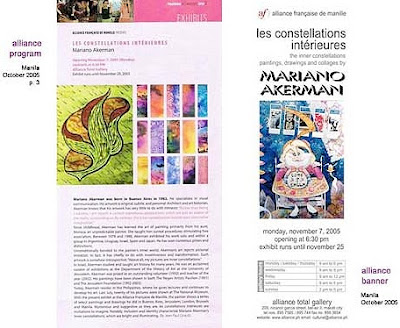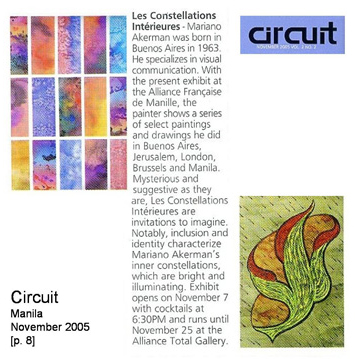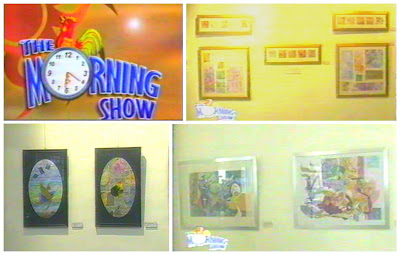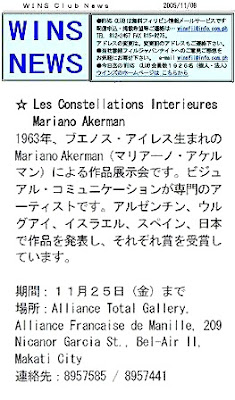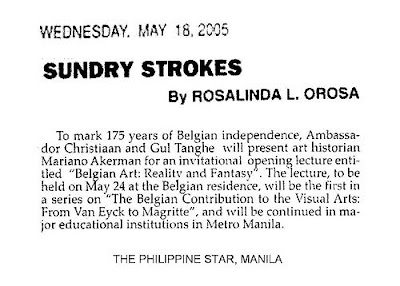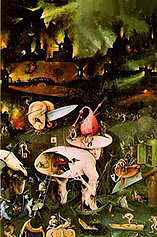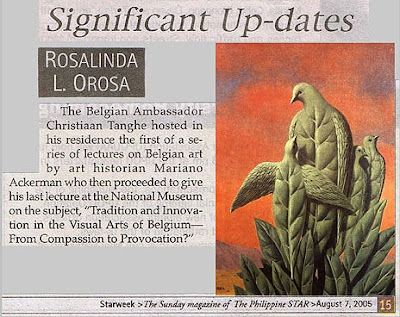JEAN PAUL GIRAULT interviews MARIANO AKERMAN
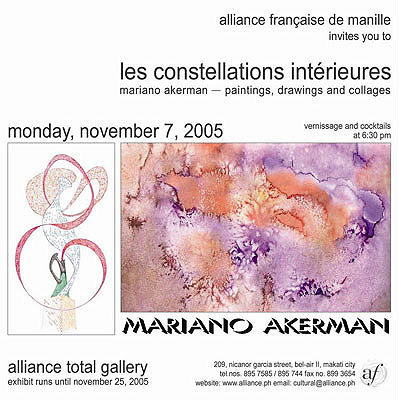
1. Akermariano, The Inner Constellations: Paintings, Drawings and Collages, 2005
2. Serenity, 2004 (mixed media collage).
JEAN-PAUL GIRAULT interviews AKERMARIANO, August 2005
Is inspiration important to your work?
Yes. But inspiration is erratic and relates to chance.
3. Gold and ashes, 2001 (ink and watercolor).
So what can you do about it?
To follow my states of mind, which also change, and to commit myself to art.
4. Pipedream, 2002-2005 (watercolor).
Is that to paint?
To paint and to research.
5. Polaris, 2002-2005 (watercolor).
What sort of research are you interested in?
The research of identity and transformation.
6. Creation-Destruction Principle, 2003-2005 (watercolor).
Are you trying to find definitions?
No. I am trying to express myself.
7. A Blooming Spot, 2003-2005 (watercolor).
Is that easy?
Sometimes.
And has that to do with inspiration?
Instead of talking about inspiration, I prefer to talk about sources of inspiration.
8. In Movement, 1990 (mixed media).
9. The Adventures of Baron Munchausen, 1988 (stills); In Movement (detail).
Why?
I believe in will, not in inspiration.
10. The Surprise, 2004 (crayon and watercolor).
Could you explain yourself?
Art is a process, not just an accident.
11. Constellation A 1-15, 2000-2005 (crayon and watercolor); Constellation B 1-15, 2000-2005 (watercolor).
Are you against accidents in art?
No. But there is no art without design.
12. The Messenger, 1990 (mixed media); Auricular Caprice, 1996 (pen).
Since childhood you have learned Surrealist procedures such as automatism, which involves the rejection of logic…
It’s true. However, concerning my work, as soon as I was conscious of the importance of my feelings and ideas, I transformed accident into designed accident.
13. Noga, 2003 (watercolor); Centaur, 1990 (ink).
Is your art free?
Not entirely. And I don’t want it to be so. Unfortunately, there is not such a thing as absolute freedom in art. That’s an illusion.
14. Red Sea, 2002 (watercolor).
Has your work to do with illusion?
No. It has to do with reality.
15. Life Supporter, 1990 (mixed media).
But your images look like dreams and fantasies…
Dreams and fantasies are also a part of reality.
16. A Sky of Projects, 1990 (mixed media).
Is it true that you regarded some paintings by Matisse as “unfinished pictures”?
Sure. And once I even tried to correct one of them …
17. Marcelo Moreno, Mariano Akerman, 1968 (photograph); Mariano Akerman, Correction of an Unfinished Matisse, 1968 (pen).
Did you ever copy the work of the masters?
Not really. In 1976, I once reproduced Toulouse-Lautrec’s Jane Avril au Jardin de Paris. Mine was just an exercise.
You painted a 1979 gouache that can be associated with a 1789 picture by François Gérard...
Yes. I was then in high school. It was a period of oppression and repression. Fortunately, our art teacher was a sensitive person. One day she brought some reproductions of masterpieces. She kindly asked me to choose one and to transform it in my way.
Which image interested you?
One with a couple—an angel kissing a girl.
Why did you choose it?
Because there was some tenderness in it.
18. François Gérard, Psyche receiving the First Kiss of Eros, 1789 (black and white reproduction of the original oil in the Louvre).
Yes, Psyche receiving the First Kiss of Eros is a tender image. But were you able to identify the characters in Gérard’s painting?
Only Eros. I had no idea then that Psyche represented the human soul.
And what did you do?
I kept the pose of the characters, and depicted them in surreal terms.
19. Nothing of Kissing Me a Lot, 1979 (gouache).
Why Surreal?
Because I thought of Surrealism as a liberating way to express myself.
Did you do any research then?
I bought a book entitled Surrealism at the Librería Sarmiento (in Buenos Aires). The images in the book interested me a lot. I loved the presence of imagination in them.
20. Yves Tanguy, The Sun in its Shrine, 1937 (oil); Mariano Akerman, Rococo Soirée in the House of a Medieval Princess, 1979-1980 (gouache).
Did you like the work of any Surrealist in particular?
No, I liked the work of the Surrealists as a whole. I still like their work in the same way.
How did you call your gouache?
Nothing of Kissing Me a Lot.
21. Comparison: format and technique, pose and style, context and message.
Did you find inspiration in Gérard’s title?
Not really. I had a reproduction of his oil in my hands, but this had no caption whatever. I only knew what I was able to perceive in it. The image was anonymous, untitled, and undated.
So your title comes from…
From the words of a bolero—bésame mucho (kiss me a lot).
Yet, Nothing of Kissing Me a Lot is its antithesis…
Yes. But, you know, I grew up in Buenos Aires, not in Madrid. So I adapted the Spanish bolero into something that was representative of my Argentinean reality. Such a reality had little to do with requesting to be kissed, and very much with not been allowed to kiss at all. Thus, Nada de bésame mucho.
Isn’t there a tango entitled Nothing of Kissing Me a Lot ?
I don’t think so. And if there is, I’ve never heard of it. Anyway, tango is rarely about tenderness. In general, it has to do with cruelty and pain.
22. Roses All the Way, 2003-2005 (watercolor).
Is it better to kiss or to be kissed?
They are two sides of the same thing, aren’t they?
The two sides of love?
Possibly.
23. The Dream comes True, 2003-2005 (watercolor).
It was in 1989 or 1990, I think, that you painted Lots, Lots, Lots of Love. What kind of image is this?
An autobiographic one, like most of my works. To speak about the history of my work is to speak of the history of my life.
24. Lots, Lots, Lots of Love, 1990 (mixed media).
How did you conceive this picture?
As a tribute to my grandparents.
Where did they come from?
Europe. They came to Argentina before WWI.
Who is the child in the painting?
In a sense, me.
But you didn’t look like him at all…
Well, I looked like him in the attitude.
Which attitude?
That of being about to eat without saying a word.
Is he obedient then?
In this case, yes.
Why seven spoons?
Seven is a number I associate with Creation.
25. Lots, Lots, Lots of Love: Spoons (detail).
Are you suggesting love here?
Yes, the love I received from my grandparents. They always cared about me.
Unfortunately, when I painted this image they were dead. I mean, physically dead.
Physically?
Nobody really dies so far as someone remembers the person. In my painting there are five flying windows. One of them shows the three of us together, visiting a place called El Rosedal.
26. Lots, Lots, Lots of Love: Windows (detail); Family group portrait, photograph, 1968.
Where does the title of your work come from?
It’s a line in a poem by María Elena Walsh. Her work is entitled “Canción del Jardinero” (The Gardener’s Song). There you find “mucho, mucho, mucho amor.” My favorite words in the poem are in its first line: “mírenme, soy feliz” (look at me, I am happy).
What is that egg close to the child?
A friend.
27. Lots, Lots, Lots of Love: Egg (detail).
Egg motifs are frequent in your work. Why?
The egg has to do with the idea of Origin.
28. Crystalline, First Movement, 1985-1986 (tempera, ink and collage).
The origin of what?
The origin of life and art, of identity and transformation.
Are you aware of the sexual connotations of the egg motif?
Of course. Thanks to Freud everything is sexual today…
29. Three Figures by the Window, 1989, detail (see below, # 37).
Even in your work?
I suppose.
30. Auricular caprice, 1996 (pen); Sheba, 1995 (sanguine).
What about Jung?
He taught us that in every human being coexist feminine and masculine components—anima and animus.
Do they coexist in your images too?
Possibly. I don’t know.
31. Creation Day, 2003 (watercolor and tempera).
Your art has little to do with mimesis. You don’t paint what you see. Then, what do you paint?
I paint what I feel.
32. Ceibo Flower, 2004 (crayon and watercolor); Waiting in Green, 2004 (crayon and watercolor).
Do you think of your works as masterpieces?
I have the feeling that some of them are.
33. Undulating, 2001 (color pencil); Nine Candles, 2000-2005 (watercolor and collage).
But not all of them…
Well, as everything is in life, so it’s in art. There are transitions.
Transitional works?
Yes. And they are indispensable to achieve one’s goals.
Yet, some artists destroy their transitional works…
Yes, some pretend to be Mozarts of the Brush. That’s not my case. Besides, what they do with their transitional works is their own business, not mine.
Do you keep your transitional works?
Some of them.
34. Things are like This, 1981 (pen); Departure, 2003 (gouache).
Did you work with oil painting in the past?
Yes. But I prefer water-based materials, such as gouache and watercolor.
35. Wishful Thinking, 2003 (watercolor).
Why this preference?
My aunt Moroca was a painter. She worked with gouache. Being a child, and even as a teenager, I liked to visit her studio, “Taller Piruetas.” She taught me how to paint with gouache. This included the use of automatic procedures stimulating free association.
36. Anonymous, Learning automatism with Moroca, 1966 (photograph); Automatism (overlapping the reproduction of James Ensor’s Intrigue, 1890), 1967 (pencil).
And watercolor?
This I’ve learned by myself.
37. Three Figures by the Window, 1989 (watercolor, tempera and ink).
Drawing is important to you, isn’t it?
Yes. Lines fascinate me.
38. Vanity of Vanities, 2004 (crayon and watercolor).
Besides, you are an architect…
Right.
39. Homage to the French Revolution, 1989 (color pencil and ink).
There are also very subtle textures in your works.
Well, they sometimes suggest figures.
40. Dead Sea 1, 1991 (ink and watercolor).
41. Dead Sea 2, 1991 (ink and watercolor).
42. Recollection, 2004 (water-soluble crayon).
Somebody once said that your work is sort of experiment, do you agree?
Of course. I see no problem in experiments, but in the formula.
43. The Magician, 2003 (watercolor).
Repeating oneself?
Exactly. As when someone has a personal style, but keeps on producing the same type of work all the time. That’s safe mediocrity.
Are you for taking risks?
I am for exploration. A series of works shouldn’t be something boring. I am for diversity.
44. Twenty-five Studies for Inner Constellations, 2000-2005 (watercolor, including some crayon).
Isn’t the repetition of a motif a symptom of sterility?
No, of course not. One may repeat a motif, but keep on changing its colors and textures.
Things can also depend on the way the image is articulated—its composition, that’s it.
45. Francophonie et Cie., 2005 (watercolor collage).
What are your pears symbolic of?
Like the egg, they have to do with the idea of the Origin. The pears also allude to earthly desires.
Earthly desires?
Yes, like the ones of Europa.
46. The Rape of Europa, 2005 (collage).
But wasn’t Zeus who had desires?
Both of them had.
À propos desire, you have also some cherries, I think.
Yes, they are curious ones.
47. The Curiosity of the Cherries, 2005 (tempera collage); Curious Cherries, 2005 (tempera collage).
In some of your works you use collage, why?
Collage expands the possibilities.
48. Friendship, 2001-2004 (tempera, watercolor and collage).
Which possibilities?
Expressive and associative ones.
49. Microcosm, 1991, revised 2005 (mixed media collage).
You also have some collages made of parts that you have painted yourself.
Yes. In the beginning, I used textures coming from all kinds of sources; later I incorporated my own textures. Today, I combine them all.
50. Among the Nations, 2005 (tempera and watercolor collage).
51. Chanel No. 5, 2005 (watercolor collage).
I think there is a part of your work in which you deal with identity.
Yes, with my own identity. I call it the Inner Story. There you find me.
52. Of the importance of the Authentic, 1987 (color pencil).
53. Central panel of the Via Dolorosa Triptych, 1997 (photograph).
54. Right-hand panel of Via Dolorosa, 1997 (photograph); compared to its ultimate source (black and white reproduction).
55. Black Milk, 2001 (watercolor and crayon); Paul Celan, “Schwarze Milch,” 1945-47: "Black milk of dawn we drink it at night / we drink it at noon in the morning we drink it at sundown / we drink and we drink" (poem excerpt).
56. Anonymous art student, Survivors, undated (gouache).
57. Jean-François Millet, The Gleaners, 1857 (oil); Survivors.
58. My Jerusalem, 1991 (watercolor, gouache, pencil and ink).
59. A Wish called Peace, 1995 (marker).
60. City of the Lord, 1992 (gouache, watercolor and ink).
Is the public interested in your work in the Philippines?
Very much so. The public also loves my art appreciation lectures. This gives me motivation to go ahead with new projects.
61. Rosalinda L. Orosa, “Sundry Strokes,” The Philippine Star, 18 May 2005.
62. F.C. Garcia, “Istilo ng sining Belgium, tinalakay sa exhibit, The Varsitarian, University of Santo Tomas, Manila, 6 August 2005.
63. Rosalinda L. Orosa, “Significant Up-dates,” Starweek, 7 August 2005.
And what about your work as an artist?
There’s also interest in my work. This possibly may stem from the “rara avis factor,” because I am quite an unusual bird in the area, aren’t I?
64. Alliance française program, October-December 2005; Alliance exhibit banner.
65. Carmencita Acosta, “Lifestyle and Culture: An appointment with art,” What’s On Expat?, 7-13 August 2005.
66. Circuit, November 2005.
67. Machelle Ramos: Interview with Mariano Akerman, National Broadcast Net, Philippines Channel 4. Teledyario, 18 November 2005; The Morning Show, 23 November 2005.
68. The Foreign Post, 24 November 2005; Compass 24/7 Nocturnal Navigator, November 2005; Ramon Lerma, “Mariano Akerman,” Philippine Star, 7 November 2005; “Les Constellations Intérieures,” Daily Tribune, 6 November 2005.
69. Newsletter of the European International School, 15 December 2005.
In a nutshell, what is your art all about?
The inner constellations.
Why?
Above all, because my pictures are inner constellations. Rather than being a camera, I am myself. A camera reproduces appearances, but the inner constellations involve one’s associative imagination.
70. Deep Inside (watercolor).
71. Invitation to The Inner Constellations Exhibit, recto.
72. Invitation to The Inner Constellations Exhibit, verso.
COMMENTS ON THE ARTIST AND HIS ARTWORK
In a world of constant exploration, the spiritual curiosity of Mariano Akerman produces true symbols of life. Bernardo Graiver
If we search a formal structure, this is evident. There’s also a strong subject matter—his work carries an interesting, vital message. Here, the simple does not exclude the profound. Monique Sasegur
His dream-inspired enigmas demand an active participation of the spectator. This is worthwhile—it is beauty itself, unfolding in an exuberant flowering. René Olivieri
He is interested in the problem of the limit. In his works, he explores the relation continent-content. Alicia Oliberos
He projects his inspiration on select images, giving to his work the mysterious charm of those things seldom seen by the human eye. Zulema Vaini
With secure hand and controlled drawing, a prolific imagination finds expression in his work. His knowledge is intermingled with a profound introspection and an almost obsessive desire to transcend the formal in order to convey profound meanings. Jorgelina Orfila
His pictorial work might be described; it could never be defined. The style is intricate, precise, richly symbolic and wholly personal. Susan Mahler
He has sensitivity to historical artistic and cultural material. […] Impressive is his ability to empathize with diverse cultural traditions and societies. Chanan Mazal
Akerman’s work speaks for inner vision; it’s almost an exploration into the painter’s soul. Some of his works recall the type of textures one can perceive with the help of a microscope. Martín Yaya
73. Macro-Collage, 2005 (digital composition).
Only a person so creative and with so much depth and inner beauty can show his interior with so much clarity and purity. I am delighted to lose myself in the inner constellations.
Adriana Morabito
74. Source of Sources: The Bible
The artwork of Mariano Akerman is original, subtle, and personal. Mysterious and suggestive as they are, les constellations intérieures are invitations to imagine.
Jean-Paul Girault
75. The Inner Constellations: Paintings, Drawings and Collages, 2006.
76. Digital Collage, 2005.
Cataloging. Akerman, Mariano. Akermariano. Les Constellations Intérieures / The Inner Constellations / Las Constelaciones Interiores. Paintings, Drawings and Collages. Solo show. Art exhibit./ Exposition d’art / Exposición de obras de arte. Alliance Française de Manille / French Alliance, Manila / Allianza Francesa de Manila. Art. Automatism. Design. Mixed Media. Photography. Literary and visual sources of inspiration and references. Belgium: 175 Years of Independence. Art-appreciation lectures in Manila. “The Belgian Contribution to the Visual Arts.” Girault, Jean-Paul. Interview with Mariano Akerman. August 2005. Insight. Dialog. Education. Media Impact.
© Mariano Akerman. All Rights Reserved. Artworks, visual sources, literary references, ideas, comments and media impact. No part of this article may be reproduced in any form and by any means (including recording, and any form of storage and retrieval), without permission in writing from the author.



